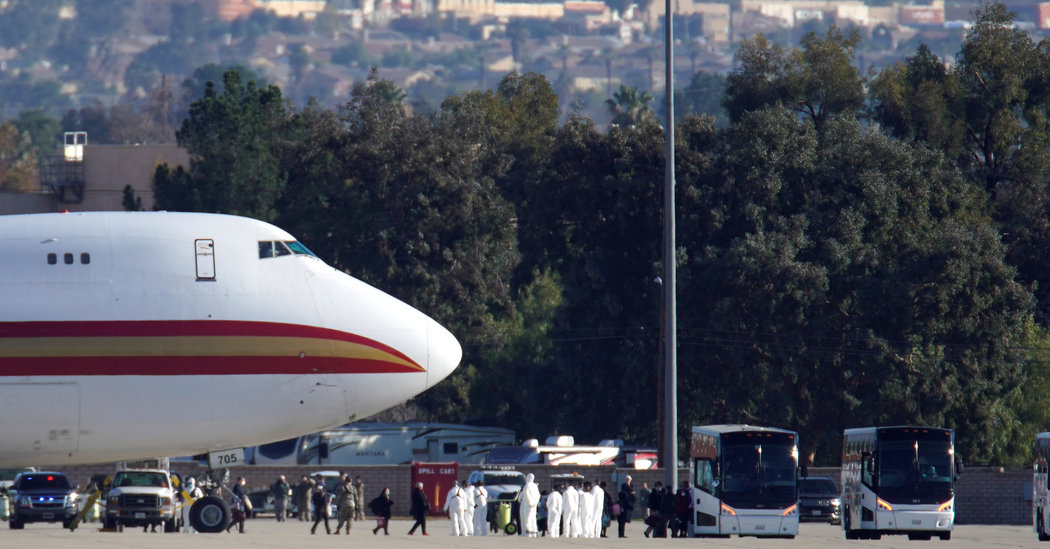[ad_1]
WASHINGTON — Federal health employees without adequate protective gear or training interacted with Americans quarantined at a military installation in California for possible exposure to the coronavirus, the top lawyer at the Department of Health and Human Services concluded on Friday.
The report validated the central claim of a government whistle-blower who raised concerns this year about the deployment of employees of the agency’s Administration for Children and Families who were dispatched in late January to help care for Americans repatriated from Wuhan, China, during the coronavirus outbreak there. The report found that proper procedures to protect the employees “temporarily broke down” amid a chaotic situation at March Air Reserve Base. But it rejected a second accusation of the same lapses at Travis Air Force Base, saying the procedures had been corrected in that instance.
“In this unprecedented, dynamic, and evolving situation, the mission command and control structure during the March deployment temporarily broke down,” the general counsel at the Department of Health and Human Services wrote, according to a summary of the report obtained by The New York Times.
The employees did not receive proper personal protective equipment, even as some of them touched evacuees, including upon their arrival, the report said. Other staff members were directed to remove their gear to avoid “bad optics,” according to multiple interviewees who spoke with lawyers with the Immediate Office of the General Counsel at the Department of Health and Human Services, which produced the report.
“The investigation concluded that during the early days of what was an unprecedented repatriation of U.S. citizens from Wuhan, China, a rapidly evolving response meant that uniform infection-control and infection-prevention measures were not initially in place at March Air Reserve Base when repatriated Americans arrived on Jan. 29,” said Caitlin B. Oakley, a spokeswoman for the health department.
Ms. Oakley noted that the investigation found that within 12 hours of the arrival, the department dispatched to the base a separate incident management team, which began providing guidance and prevention measures.
“Anecdotal evidence” of breaches of protective equipment protocol at Travis Air Force Base were “the result of individual mistakes,” the report said, not a failure on the part of the agencies handling the effort.
The report, which summed up the findings of a team of lawyers that interviewed 65 people and reviewed tens of thousands of pages of documents, offers some detail into how overwhelmed agencies were during initial federal response to the coronavirus. A separate review, conducted by the Office of the Inspector General, remains underway.
None of the federal employees involved in the deployment at the March Air Reserve Base ultimately tested positive for the virus.
A plane was on its way to Ontario Airport in California with American evacuees from Wuhan, the center of the coronavirus outbreak, in late January when federal officials decided that the proposed housing was medically inadequate and took over the repatriation from the State of California.
The plane was rerouted to March Air Reserve Base, where federal officials scrambled to make arrangements for the evacuees, the report said.
“The limited time that H.H.S. components had, as a result, to react led to failures,” the counsel’s office wrote in the summary.
Without proper personal protective equipment, multiple federal health employees, including those with the Office of the Assistant Secretary for Preparedness and Response, had to use equipment belonging to Riverside County, Calif.
Within five days of first interacting with the evacuees on the air base, some of the workers traveled to Travis and other military facilities on commercial airlines.
The lead official with the Centers for Disease Control and Prevention on the base, who was not named in the summary, repeatedly interacted closely with evacuees without proper protective equipment, according to multiple eyewitness accounts.
The health workers also were not given clear infection-control and prevention guidance for dealing with the evacuees, the report said.
When personnel asked for guidance, C.D.C. staff gave “confusing, incomplete and contradictory information,” and in some instances “set inconsistent examples with respect to their own personal use.”


















